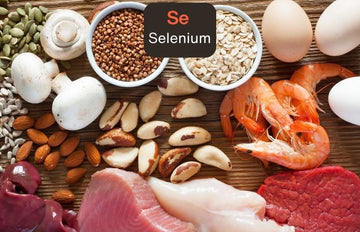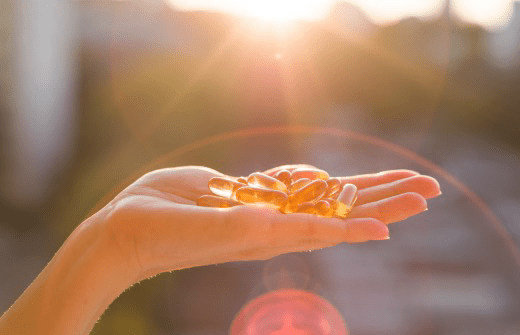As with iodine, selenium intake is dependent on the content of selenium in the soil. The amount of this element in the soil varies geographically. There are both so-called selenium-deficient areas and areas with high levels of selenium in the soil. The Czech Republic, or Europe in general, is one of the areas with low soil selenium concentrations. This is consequently reflected in the low dietary intake of this essential element. To clarify, it is not only the presence of selenium in soils that matters, but also its availability which is influenced by the organic content of the soil, pH, rainfall and, of course, by the ability of plants to absorb selenium.
Article at a glanc:
- Selenium
- Selenium and the thyroid gland
- Selenium and its biological functions
- Selenium deficiency and its manifestations
- Food sources of selenium
- Possible toxicity
- How to address selenium deficiency in our conditions?
Selenium
Although the human body requires selenium only in small amounts, it represents an essential element that plays an important role in maintaining healthy physiological functions in our organism. Selenium supports, for example, the proper functioning of the thyroid gland, fertility and a healthy immune and cardiovascular system. Selenium is found in high amounts in the liver, heart, kidneys, pancreas, testes and nails. However, the organ with the highest concentration of selenium in the body is the thyroid gland.
Selenium and the thyroid gland
Selenium helps protect the thyroid gland from oxidative damage and plays a crucial role in the production of thyroid hormones. This element is part of the enzyme iodothyronine deiodinase, which catalyzes the conversion of inactive thyroxine (T4) to active triiodothyronine (T3).
According to several studies, selenium deficiency has been associated with an increased risk of autoimmune thyroid disorders, especially Hashimoto's thyroiditis ( = an autoimmune disease in which the immune system attacks the thyroid gland). Literature also suggests that selenium supplementation in patients with autoimmune thyroid disorders reduces the production of anti-thyroid peroxidase antibodies (so-called anti-TPO).
Selenium and its biological functions
Selenium is part of glutathione peroxidase, an important endogenous antioxidant that helps protect membrane lipids from oxidative damage caused by free radicals. Oxidative stress has been linked to a number of diseases, such as heart disease and atherosclerosis. That is why glutathione peroxidase can protect us against diseases connected with oxidative stress. Glutathione peroxidase activity is also used as a marker to assess the amount of selenium in the body.
Selenium also strengthens the function of the immune system. The necessary level of this element increases the production and efficiency of white blood cells and protects them from free radicals. Selenium is also an important element for maintaining a healthy reproductive system. In men, it forms part of the sperm flagellum and is needed for proper testosterone metabolism.
Furthermore, selenium acts as an antagonist of cadmium, arsenic, mercury and lead. By binding to these elements and blocking their absorption, it helps in protecting against their toxic effects.
Selenium deficiency and its manifestations
As mentioned above, selenium deficiency is associated with thyroid disorders such as hypothyroidism or Hashimoto's thyroiditis. In China, which is one of the areas with very low concentrations of selenium in the soil, severe deficiency of selenium is associated with Keshan and Kashin-Beck disease. However, both of these conditions also occur in association with iodine deficiency or the presence of certain environmental toxins. In the case of Keshan's disease, the presence of a viral infection has also been identified.
Food sources of selenium
Selenium available from the diet is bound to proteins. Therefore, foods high in protein, such as meat (especially offal) and other animal products, are relatively good sources of selenium. Regarding plant sources, brazil nuts are significant for their selenium content and can contain up to 100 mcg /100g. Since the content of selenium in foods depends on the selenium content in the soil, it is advisable to include multiple selenium sources in the diet. There are studies that confirm that the concentration of selenium in brazil nuts varies significantly depending on where the nuts come from.
Possible toxicity
However, there is a relatively thin line between optimal intake and toxic levels of selenium. For example, if we eat large amounts of the above-mentioned brazil nuts, we can be poisoned. This can already occur with doses corresponding to 600-700 mcg of selenium per day. Symptoms of selenium overdose include garlic breath, vomiting, brittle nails, hair loss, fatigue or irritability.
How to address selenium deficiency in our conditions?
Unfortunately, people with normal eating habits who have conventionally produced foods in their diet are experiencing a modern form of malnutrition and lack key elements such as selenium.
If you are not a nutritionist and cannot assess which essential substances are missing in your diet, it is smart to supplement the most fruquently deficient nutrients. That's why the Multivitamin Daily F20 Complex was created. The daily use of this Multivitamin will help you to improve your nutritional status and guarantee the intake of important nutrients. Personalized supplementation focusing only on the proven missing nutrients is more appropriate, but if you do not want to deal with nutrition and supplementation individually with a qualified specialist, bet on our Multivitamin Daily F20 Complex.
Sources:
Stoffaneller R, Morse NL. A review of dietary selenium intake and selenium status in Europe and the Middle East. Nutrients. 2015 Feb 27;7(3):1494-537. doi: 10.3390/nu7031494. PMID: 25734564; PMCID: PMC4377864.
Ventura M, Melo M, Carrilho F. Selenium and Thyroid Disease: From Pathophysiology to Treatment. Int J Endocrinol. 2017;2017:1297658. doi: 10.1155/2017/1297658. Epub 2017 Jan 31. PMID: 28255299; PMCID: PMC5307254.
Qian Wu, Margaret P. Rayman, Hongjun Lv, Lutz Schomburg, Bo Cui, Chuqi Gao, Pu Chen, Guihua Zhuang, Zhenan Zhang, Xiaogang Peng, Hua Li, Yang Zhao, Xiaohong He, Gaoyuan Zeng, Fei Qin, Peng Hou, Bingyin Shi, Low Population Selenium Status Is Associated With Increased Prevalence of Thyroid Disease, The Journal of Clinical Endocrinology & Metabolism, Volume 100, Issue 11, 1 November 2015, Pages 4037–4047
E.C. Silva Junior, L.H.O. Wadt, K.E. Silva, R.M.B. Lima, K.D. Batista, M.C. Guedes, G.S. Carvalho, T.S. Carvalho, A.R. Reis, G. Lopes, L.R.G. Guilherme,
Natural variation of selenium in Brazil nuts and soils from the Amazon region,
Chemosphere, Volume 188, 2017
Fan Y, Xu S, Zhang H, Cao W, Wang K, Chen G, Di H, Cao M, Liu C. Selenium supplementation for autoimmune thyroiditis: a systematic review and meta-analysis. Int J Endocrinol. 2014;2014:904573. doi: 10.1155/2014/904573. Epub 2014 Dec 11. PMID: 25574167; PMCID: PMC4276677.


















